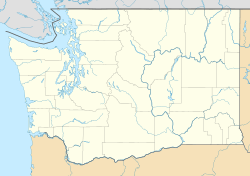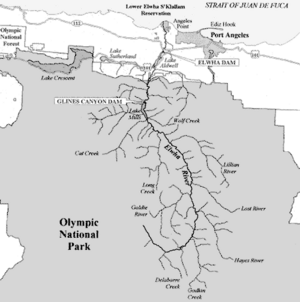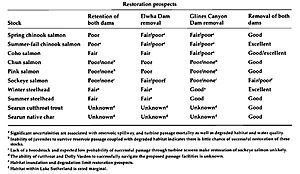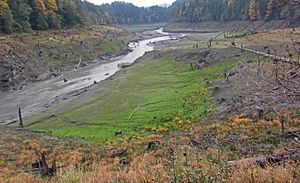Elwha Dam facts for kids
The Elwha Dam was a 108-foot (33 m) tall dam in the United States, located in Washington on the Elwha River. It was about 4.9 miles (7.9 km) upstream from where the river meets the Strait of Juan de Fuca.
The dam was built to create electricity. However, it caused big problems for the river's natural environment and the fish that lived there. Because of this, the US Federal Government decided to remove it. The Elwha River Ecosystem and Fisheries Restoration Act of 1992 allowed the government to buy the Elwha Dam and the nearby Glines Canyon Dam so they could be taken down to help restore the river's habitat. The removal of the Elwha Dam started in September 2011 and was completely finished by March 2012. This allowed the Elwha River to flow freely again.
Quick facts for kids Elwha Dam |
|
|---|---|
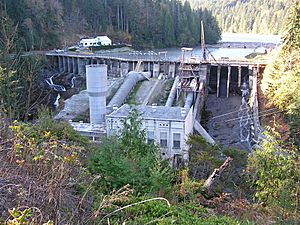
Elwha Dam in 2005
|
|
| Location | Clallam County, Washington, USA |
| Construction began | 1910 |
| Opening date | 1913 |
| Demolition date | 2012 |
| Dam and spillways | |
| Impounds | Elwha River |
| Height | 105 ft (33 m) |
| Reservoir | |
| Creates | Lake Aldwell |
| Power station | |
| Installed capacity | 14.8 MW |
|
Elwha River Hydroelectric Power Plant
|
|
| Location | On Elwha River, end of Lower Dam Road, about 6 miles (9.7 km) southwest of Port Angeles |
| Area | 3.5 acres (1.4 ha) |
| Built | 1911 |
| Architect | L.L. Summers & Company |
| Architectural style | Concrete gravity dam |
| MPS | Hydroelectric Power Plants in Washington State, 1890--1938 MPS |
| NRHP reference No. | 88002741 |
| Added to NRHP | December 15, 1988 |
Contents
Building the Dam
The Elwha Dam was built under the direction of Thomas Aldwell. He bought land around the river and, with help from a Canadian investor named George Glines, started building the dam in 1910.
Early Problems
Aldwell and his builders cut corners during construction. They did not build special passages for fish to swim through, and they didn't secure the dam properly to the ground. In 1912, as the lake behind the dam filled up, the lower parts of the dam broke. A huge rush of water flowed downstream, destroying a bridge.
Aldwell managed to get more money to rebuild the dam, and it was finished in 1913. The lake that formed behind it was called Lake Aldwell. The area around the dam, including the powerhouse, was listed on the National Register of Historic Places in 1988 because of its historical importance.
Dam's Purpose and Impact
At first, the Elwha Dam, along with the Glines Canyon Dam (finished in 1926), helped the economy grow in the Olympic Peninsula and the city of Port Angeles. However, by the early 2000s, both dams together only produced enough electricity for about 38% of what one paper mill needed.
A major problem was that the dam had no way for migrating salmon to pass. This blocked fish from reaching 38 miles (48 km) of their natural river habitat and over 30 miles (48 km) of smaller streams. Before the dam, more than 400,000 adult salmon would return to the river. After the dam, fewer than 4,000 salmon returned, and they could only use about 4.9 miles (7.9 km) of the river.
How the Dam Changed the River
After the dams were built, the lower part of the river received much less gravel and dirt. This caused the riverbed to wash away, including the gravel beds that salmon need to lay their eggs. The gravel that was supposed to go downstream got stuck behind the dams. This gravel is very important for restoring salmon habitats. The river's delta, where it meets the Strait of Juan de Fuca, also started to wash away, which local tribal leaders confirmed.
Effects on Water Temperature and Flow
The dams also created Lake Aldwell and Lake Mills. These lakes had many effects on the river, not just holding back dirt. Because the water stayed in the lakes for a long time, it warmed up to about 16 °C (61 °F). Normal river temperatures are much colder, around 0 °C (32 °F). These warmer temperatures are not good for spawning fish, which prefer colder ocean-like water.
The warmer water also caused more parasites to grow, which threatened the salmon. In 1992, a disease wiped out two-thirds of a type of salmon called Chinook before they could lay their eggs. The lakes also changed the river's natural flow. The dams were not used to control floods, but the lakes behind them made the river's flow more constant throughout the year. Natural changes in river flow are important for healthy native fish and plants.
History of Elwha Fish
At its best, the Elwha River supported many types of salmon, including Chinook, Coho, Chum, Pink, and Sockeye. It also had Steelhead, Cutthroat, and Bull Trout. Some Chinook salmon were known to grow very large, up to 45 kg (100 lbs). Sockeye, Chinook, Chum, and Pink Salmon were all in danger of disappearing from the Elwha River.
Even if fish ladders were added to the dams, leaving one or both dams in place would not have helped the fish recover much. This is because other problems, like warm water and lack of gravel beds, would still harm the fish. The most important places for salmon to lay their eggs were far upstream, beyond the Glines Canyon Dam. So, that dam was a major block to the fish recovering. Because of all these reasons, removing both dams was seen as the only real way to fully restore the river and its habitats.
Removing the Dam
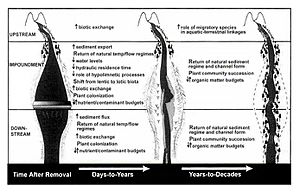
The Elwha River Ecosystem and Fisheries Restoration Act of 1992 provided money and government support to deal with the dams on the Elwha. Even though fish ladders were considered, they were eventually ruled out because they wouldn't solve all the problems.
Managing Sediment
A big challenge with removing the two dams was the huge amount of dirt and sediment that had built up behind them. About 34 million cubic yards of sediment were trapped, with 6 million behind the Elwha Dam and 28 million behind the Glines Canyon Dam. Releasing all this sediment at once would have been very bad for the remaining habitats downstream and for the beaches along the coast.
Scientists did an experiment at the Glines Canyon Dam to see how the sediment would erode from Lake Mills. They lowered the lake level by 18 feet (5.5 m) over one week and then kept it steady for another week. This test showed that the river would quickly cut a deep, narrow channel into the existing sediment as the lake level dropped. A new area of sediment would immediately form at the new lake level. Once the lake level was held steady, the channel would move sideways along the existing sediment.
This test helped create a model for how to remove the dams. The plan was to lower the lake levels slowly over two years. This would allow much of the sediment to stay in the old lake beds, preventing a sudden rush downstream.
River Restoration and Future
The model showed that after the two-year dam removal period, the river would start to return to its natural state. More sediment would flow downstream, which would help restore and refresh the habitats below the dams. Fish were expected to return to the upper parts of the Elwha River as soon as a year after the dams were fully removed.
While the river might not ever have as many fish as it did historically, after 15–20 years or more, salmon populations should recover to a "pre-dam" condition. Besides restoring fish habitats, draining Lake Mills and Lake Aldwell would create an additional 715 acres (2.9 km²) of land for plants, which would improve habitats for elk. More sediment flowing down the river was also expected to help restore the shrinking delta at the mouth of the Elwha.
The physical removal of the dams on the Elwha River began on September 27, 2011, and was completed on August 26, 2014. Scientists are studying how the river will change and how long it will take to fully recover. Since very few dam removal projects have been studied scientifically, this project will be an important example of how effective large-scale dam removal can be. If the river restoration is successful, it could encourage more projects to remove large dams and restore natural river shapes. Most fish populations are expected to return to the river. While fish might return within a year, it could take 15 to 20 years for the river to fully return to its condition before the dams were built. The main goal of removing the dams is to bring the river back to a nearly natural state.
Images for kids


